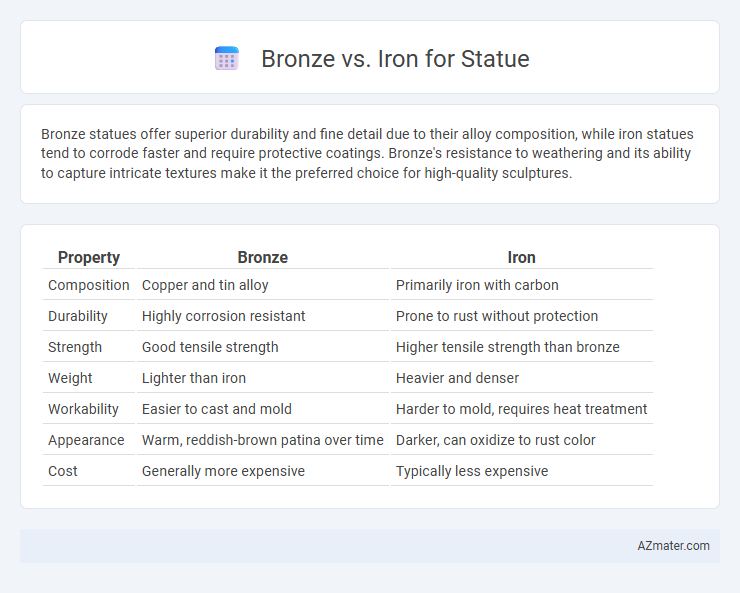Bronze statues offer superior durability and fine detail due to their alloy composition, while iron statues tend to corrode faster and require protective coatings. Bronze's resistance to weathering and its ability to capture intricate textures make it the preferred choice for high-quality sculptures.
Table of Comparison
| Property | Bronze | Iron |
|---|---|---|
| Composition | Copper and tin alloy | Primarily iron with carbon |
| Durability | Highly corrosion resistant | Prone to rust without protection |
| Strength | Good tensile strength | Higher tensile strength than bronze |
| Weight | Lighter than iron | Heavier and denser |
| Workability | Easier to cast and mold | Harder to mold, requires heat treatment |
| Appearance | Warm, reddish-brown patina over time | Darker, can oxidize to rust color |
| Cost | Generally more expensive | Typically less expensive |
Introduction to Bronze and Iron Statues
Bronze statues are crafted using an alloy primarily composed of copper and tin, offering excellent durability, corrosion resistance, and fine detail in sculpting. Iron statues, typically made from cast or wrought iron, exhibit greater strength but are more prone to rust and require protective coatings for outdoor display. Both materials have historic significance, with bronze favored for its longevity in art and iron valued for its structural robustness.
Historical Significance of Bronze and Iron Sculptures
Bronze sculptures have held historical significance due to their durability and the intricate detail achievable through the lost-wax casting method, making them prominent in ancient civilizations such as Greece and Rome. Iron sculptures emerged later, symbolizing industrial progress during the 19th century, with the material's strength allowing for larger, more robust public monuments. The transition from bronze to iron in statues reflects technological advancements and shifts in cultural values surrounding art and engineering.
Composition and Material Properties
Bronze, primarily an alloy of copper and tin, offers excellent corrosion resistance and a lower melting point, making it ideal for detailed and durable statues. Iron, especially cast iron, contains carbon and small amounts of silicon and manganese, providing higher strength but increased susceptibility to rust without protective coatings. The superior tensile strength and finer grain structure of bronze enable intricate sculpting, while iron's density and weight make it better suited for large, robust installations.
Durability and Longevity Comparison
Bronze statues exhibit superior durability compared to iron, as bronze resists corrosion and weathering more effectively, ensuring longevity in outdoor and humid environments. Iron is prone to rust and structural degradation over time without protective coatings, reducing its lifespan significantly. The inherent corrosion resistance and mechanical strength of bronze make it the preferred choice for long-lasting, outdoor sculptures.
Aesthetic Qualities: Color, Texture, and Patina
Bronze statues exhibit a rich, warm color range from golden brown to deep reddish hues, offering a smooth texture that enhances intricate details and develops a unique patina over time, which adds depth and character to the artwork. Iron statues typically have a darker, more industrial appearance with a rougher texture that reflects a raw, rugged aesthetic, and while iron can rust, the resulting weathered patina is less stable and often seen as corrosion rather than artistic aging. The evolving patina on bronze is prized for its protective qualities and visual appeal, making bronze a preferred medium for artists seeking both durability and refined, timeless beauty in their sculptures.
Cost Effectiveness of Bronze vs Iron Statues
Bronze statues typically offer greater cost effectiveness due to their long-lasting corrosion resistance and lower maintenance expenses compared to iron, which is prone to rust and requires frequent upkeep. Although bronze has a higher initial material cost, its durability reduces replacement and repair expenditures over time, making it a more economical choice for outdoor sculptures. Iron statues may have a lower upfront price but can incur significant long-term costs from protective coatings and environmental damage.
Maintenance and Preservation Requirements
Bronze statues require less frequent maintenance due to their natural corrosion resistance, developing a stable patina that protects the metal while enhancing aesthetic appeal. Iron statues are more prone to rust and corrosion, necessitating regular cleaning, protective coatings, and controlled environmental conditions to prevent deterioration. Preservation of iron sculptures often involves specialized treatments such as rust inhibitors and controlled humidity to ensure structural integrity and longevity.
Suitability for Indoor vs Outdoor Installations
Bronze exhibits superior weather resistance and durability, making it ideal for outdoor statues exposed to elements like rain, wind, and UV rays. Iron, prone to rust and corrosion without protective coatings, is better suited for indoor installations where environmental exposure is limited. For long-lasting outdoor displays, bronze ensures minimal maintenance and preserves intricate details, while iron requires regular upkeep to prevent deterioration.
Popular Uses and Iconic Examples
Bronze is favored for statues due to its durability, fine detail reproduction, and historical significance in classical art, exemplified by iconic works like Michelangelo's David (bronze casts) and Rodin's The Thinker. Iron, though less common for detailed sculptures, is popular for larger, industrial-style statues and structural art pieces, as seen in the Eiffel Tower's intricate iron latticework. Bronze's weather resistance makes it ideal for outdoor monuments, while iron's strength suits functional and monumental installations.
Choosing the Right Material for Your Statue
Choosing between bronze and iron for your statue hinges on durability, aesthetic appeal, and maintenance requirements. Bronze offers excellent corrosion resistance and develops a desirable patina over time, enhancing long-term beauty, while iron is prone to rust and requires protective coatings for outdoor displays. Understanding environmental exposure and desired visual effects ensures selecting the most suitable material for lasting artistic impact.

Infographic: Bronze vs Iron for Statue
 azmater.com
azmater.com